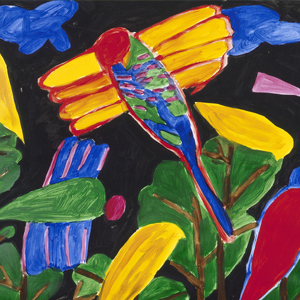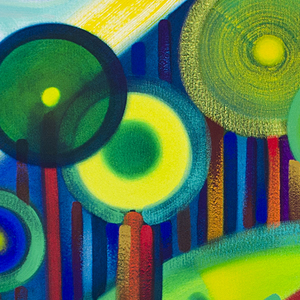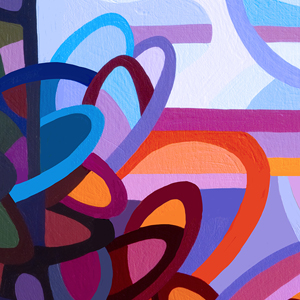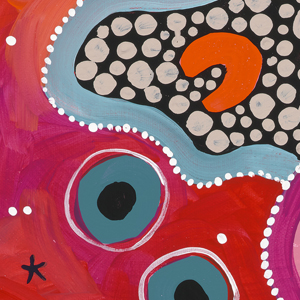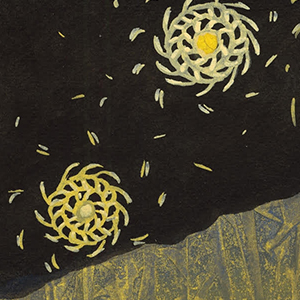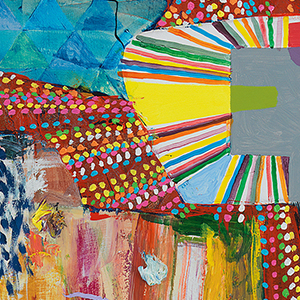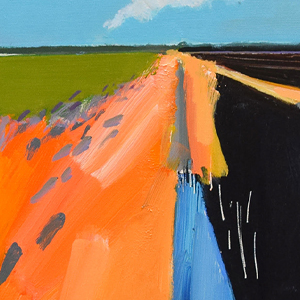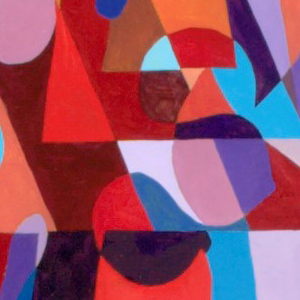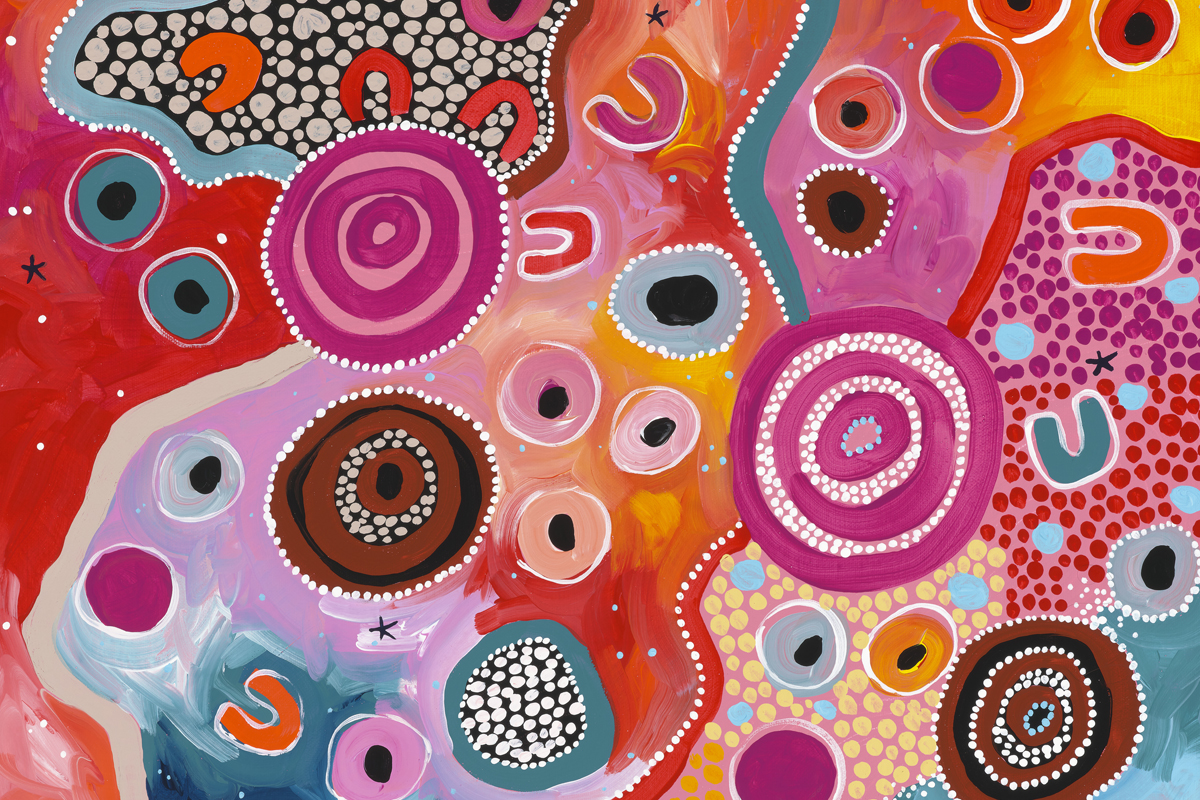
PURSUING VIRTUE
Blest Be the Ties that Bind
Remembering a Purpose of Religio in Higher Education
Luke A. Powery
Artwork: “Fire, Water and Country” by Emma Hollingsworth © 2021
Blest be the tie that binds
Our hearts in Christian love;
The fellowship our spirit finds
Is like to that above.
—John Fawcett
There is a breach in our world.
A breach is a breaking, a gap, a hole, a divide in something that was once whole. I am not sure how whole we have ever been as the human race, but the breach is on full display these days through inhumane physical and linguistic violence—from international wars to mass shootings to political fights.
Poet Warsan Shire describes holding a world atlas map on her lap and running her fingers across the whole world. She whispered this question to the world, “Where does it hurt?” and the world answered, “everywhere, everywhere, everywhere.”1 This includes the United States of America, that is more like the divided states of America. The perpetual violence should cause us to tremble in the face of incarnate terror but not numb us into social paralysis and inaction nor make us revolutionaries of retribution. Human hearts should be hurting and our souls aching, but the world is waiting for hopeful responses.
In times like these, there have to be multifaceted solutions to the pandemic of violence. One step or approach will not do. A part of the solution, I believe, is religio. Religio is the Latin word for ‘religion.’ It is a part of Duke University’s historic motto—eruditio et religio, ‘knowledge and religion’ or better, ‘knowledge and vital piety,’ taken from a Charles Wesley hymn in which he talks about uniting “the pair so long disjoined.”2 Serving as the Dean of Duke University Chapel provides me the opportunity to emphasize, embody, promote, represent, and moderate this joining in higher education, in general, but particularly at Duke. Because Duke University Chapel is located at the center of the university, religio is architecturally and figuratively at the heart of the university. This essay is a brief attempt to remember a critical purpose and promise of religio for higher education.
A Purpose of Religio
Even if one is not a religious person in the traditional sense, it is important to remember, especially in light of the vast societal breaches, that the etymological roots of religio mean “to bind” or “to tie together.” Actually, this is what religious practice is ultimately all about—binding us to God and to one other. Again, even if one is not into “God-talk,” the idea of being bound together can be a constructive aspiration in the face of devastating social chasms. Religio, therefore, is both theological and sociological, and it is the latter that is the emphasis of this essay.
In discussing religio, I do acknowledge how often it—that is, religious people, religious institutions, religious practices—has not bound people together or bound people to God, but rather has divided and created a breach in human society. Religio, at times, has been ruinous. It has created chasms. It has hurt. It has burned people, literally, throughout history.
But what is also true—and this is what gets lost in the cacophony of complaint and criticism sometimes—is that religio has spurred a lot of good in the world as well, including social justice movements, creation of hospitals, and the establishment of colleges and universities. Religio has been a balm, and not just a bomb. The roots of religio spurred both the Rev. Dr. Martin Luther King, Jr., to strive toward “the world house”3 and the Rev. Howard Thurman to follow “the scent of the ties that binds . . . .”4 At its best, this is what religio does—it joins us together into a deeper sense of communion across the divides.
This should spark a sense of hope in what is possible in higher education through religio. In the face of conflicts over global or local topics and the challenge to nurture civil discourse on campuses, religio has a place to play in bringing disparate groups together. The reality is also that religion is not disappearing on university campuses but rather reemerging and being reengaged in new ways and forms. As one book’s title proclaims, religion in university education is No Longer Invisible.5 Another book speaks of The Resilience of Religion in American Higher Education.6 There is a future for religio in higher education and one of its key purposes is to be a resource to repair the social breach, to work toward becoming more bound to one another as human beings, to embrace our mutuality, to affirm the dignity of all people, and to stop the hate, the violence, the vicious vitriol against one another in whatever form. Religio can foster a deep sense of the ties that bind us together in God and with each other.
The Promise of Religio
Remembering this critical purpose of religio offers a promise in higher education that can be viewed as a blessing because, as the South African bishop Desmond Tutu once wrote, “all of us are made for togetherness.”7 Remembering the core purpose of religio might help us re-member our shared humanity instead of all of the social splintering. Barbara Brown Taylor concurs implicitly when she writes: “When my religion tries to come between me and my neighbor, I will choose my neighbor. That self-canceling feature of my religion is one of the things I like best about it. Jesus never commanded me to love my religion.”8
These theologians point us to a truth from the Book of Genesis in the Hebrew Bible, but it is contained in other faiths as well: We are all dust, humus, “from the earth,” and to dust we will return. Our common ground is that we are all from the ground. We are bound to each other in the ground of God. This is grounds for acknowledging our common humanity and respecting, honoring, and valuing all people, thus affirming the humanity of the other.
In his book, Just Mercy, Bryan Stevenson discusses an encounter that shaped his career. He was a legal intern working in Georgia when he visited a man on death row named Henry to tell him that he would not be executed in the next year. What was supposed to be a short meeting lasted three hours. He writes, “It turned out that we were exactly the same age. Henry asked me questions about myself, and I asked him about his life. Within an hour we were both lost in conversation. We talked about everything . . . . I was completely absorbed in our conversation. We laughed at times, and there were moments when he was very emotional and sad.”
Stevenson is even more struck when Henry is shackled again and while being taken away, begins to sing the Christian hymn “Higher Ground.” This religious song completes the shift in Stevenson. He says, “I didn’t expect [Henry] to be compassionate or generous. I had no right to expect anything from a condemned man on death row. Yet he gave me an astonishing measure of his humanity. In that moment, Henry altered something in my understanding of human potential, redemption, and hopefulness.”9
Henry was charged for committing a crime but he, himself, was not a crime. He was human and shared his humanity with Stevenson, and vice versa. Stevenson experienced the ties that bound him to Henry as a fellow human being. But it was the hymn, the religious song, the expression of religio, that completed the metamorphosis and tightened the forming bond between them, so that the other was affirmed. This is what religio can do in any setting, even in a prison.
In the Spring semester of 2023, I taught a divinity school course on the Spirituals in a federal men’s prison. The class was made up of ten divinity school students and twelve incarcerated students. Every Thursday morning, we had to pass through security to reach the human flesh of those in prison. For one class session, we were having a conversation about lament and hope, particularly in the spiritual, “There is a Balm in Gilead.” This religious song speaks to the human condition clearly: “Sometimes I feel discouraged and think my work’s in vain. But then the Holy Spirit revives my soul again. There is a balm in Gilead . . . ”
When the discussion was over and we took a break, one of the incarcerated students showed me something he had written down. He had written the word ‘lament’ on a white piece of notebook paper but around four letters in that word, he drew a box. Those four letters inside the word “lament” made up the word “amen.” He showed me that there is an “amen” inside of every lament. For him, it meant hope in the midst of trials. There is no lament without an amen. I have been researching lament in preaching and theology for twenty years and had never seen this! A so-called threat, a prisoner, became my professor on that day. Again, it was a religious song, a spiritual, the expression of religio, that bound us together in such a way that I could learn from the human other in humility. Religio tied us together in a bond of lament and hope, a bond that was actually a balm. This is what religio can do in any setting, including a university course within a prison.
The promise of religio is that it can resist the violence that acts as if we are domineering lords in control over each other’s lives. Multifaceted violence has formed a breach in the United States and abroad. I believe religio can help repair it. Through the work of chaplains and campus ministers at colleges and universities, the purpose of religio can be remembered and renewed for such a time as this. It holds a promise for the future of higher education at Duke and beyond because it is actually the bond of love that ties us all together in the harmony of hope. It is a healing source for this wounded world.
In the face of the shocking violent assassination of Dr. King, the words of Howard Thurman then, still speak now, and points implicitly to a reason why there needs to be a revival of religio in the world:
“it is the intent of life, that we, that we shall all be one people. For better or for worse we are tied together in one bundle and I can never be what I must be until you are what you must be: for better or for worse this is the only option. And to reject it is to reject life. And to reject life is…to make God repent that he ever gave us a chance to live . . .”10
Notes
- Warsan Shire, “What They Did Yesterday Afternoon,” verse.press/poem/what-they-did-yesterday-afternoon-6524900794187889060.
- Sam Wells, “Eruditio et Religio,” chapelarchives.oit.duke.edu/documents/sermons/Oct4EruditioetReligio.pdf
- Martin Luther King, Jr. Where Do We Go From Here: Chaos or Community? (orig. 1967; Boston: Beacon Press, 2010), 177–202.
- Howard Thurman, The Search for Common Ground: An Inquiry into the Basis of Man’s Experience of Community (orig. 1971; Richmond, IN: Friends United Press, 1986), xiii.
- Douglas Jacobsen and Rhonda Hustedt Jacobsen, No Longer Invisible: Religion in University Education (New York: Oxford University Press, 2012).
- John Schmalzbauer and Kathleen A. Mahoney, The Resilience of Religion in American Higher Education (Waco: Baylor University Press, 2018).
- Desmond Tutu, In God’s Hands (London: Bloomsbury, 2014), 34.
- Barbara Brown Taylor, Holy Envy: Finding God in the Faith of Others (San Francisco: HarperOne, 2019), 208.
- Bryan Stevenson, Just Mercy: A Story of Justice and Redemption (New York: Spiegel & Grau, 2015), 10–12.
- Howard Thurman, “Litany and Words in Memoriam: Martin Luther King, Jr.,” April 7, 1968, bu.edu/htpp/files/2017/06/1968-4-07-Litany-Words-in-Memoriam-of-MLK.pdf.

Luke A. Powery is the Dean of Duke University Chapel and Professor of Homiletics and African and African American Studies. His teaching and research interests are at the intersection of preaching, pneumatology, music, and culture, particularly expressions of the African diaspora. His book, Becoming Human: The Holy Spirit and the Rhetoric of Race, was awarded the 2023 Book of the Year from the Religious Communication Association and the 2023 Book of the Year from the Academy of Parish Clergy.
Spring 2024
Part I: Pursuing Virtue
L. Gregory Jones
Sabrina B. Little
Kelli Reagan Hickey
Jesse S. Summers
Interlude: Purposeful Pursuits
Howard Gardner
Part II: Pursuing Vocation
Clayton Spencer
James Coleman, Jr.
James and Margaret Plews-Ogan
Carolyn Woo
MORE





